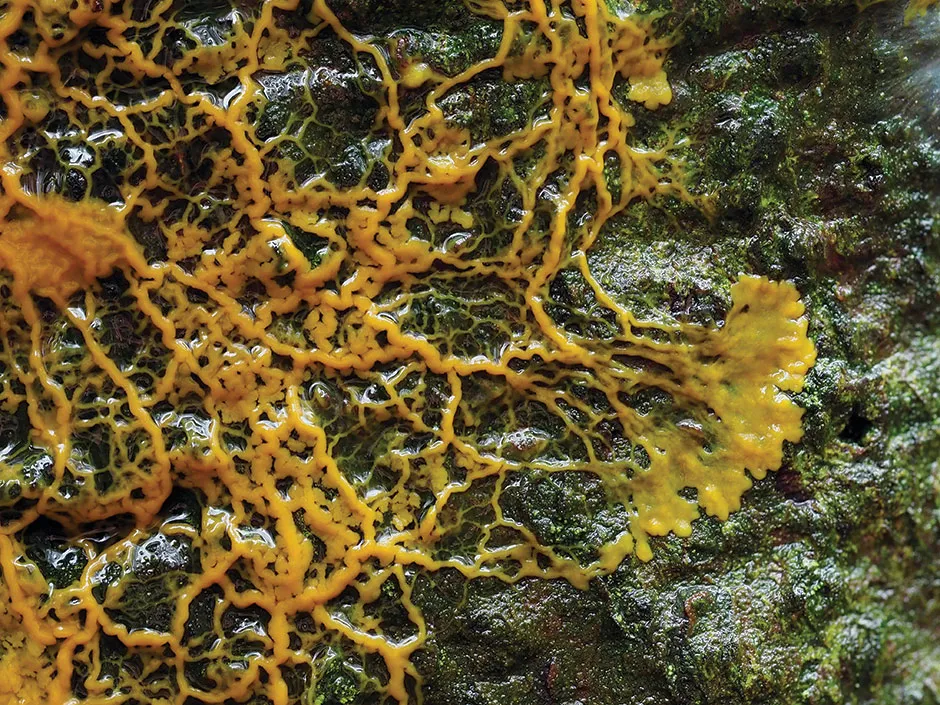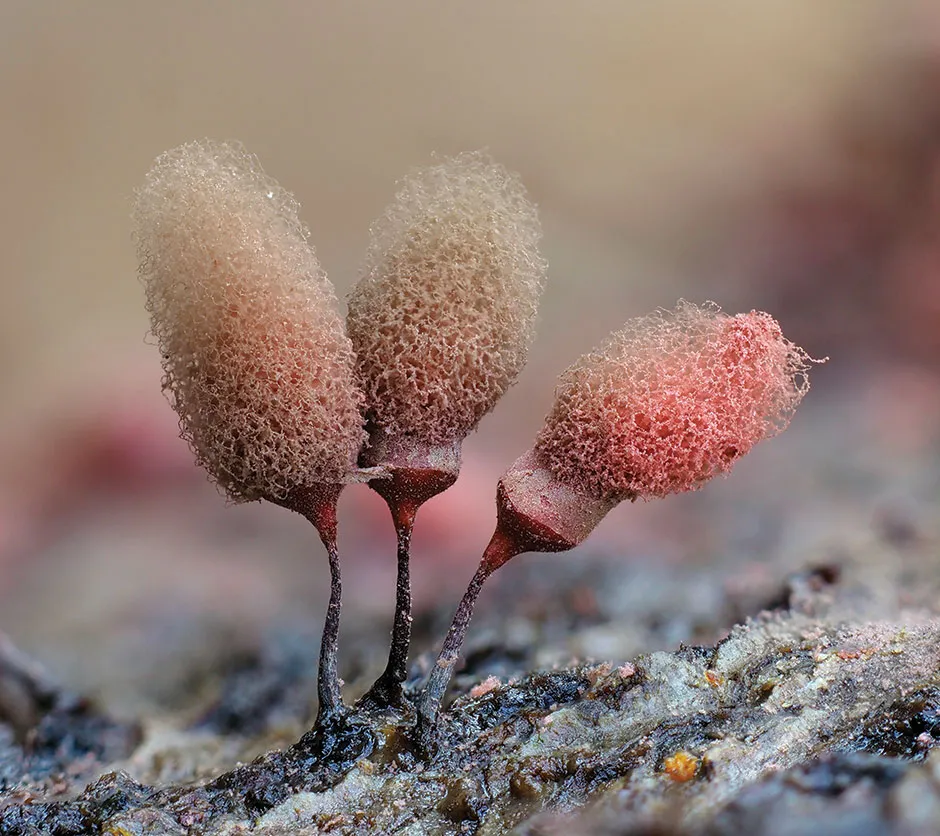The Paris Zoological Park opened an exhibit like no other in October 2019. Inside the glass tank, to the amazement of passers-by, was an organism that could think yet had no brain. That could remember without experiences. That could build information networks with an efficiency unmatched in the history of the human species. It was a slime mould. They called it ‘Le Blob’.
Slime moulds rarely feature in pub quizzes or nature documentaries, so why should we care about them? Let’s start with the basics. First, slime moulds aren’t just one kind of organism, but are rather a collective of organisms that closely resemble amoebae. Most slime moulds live out their lives as single-celled microorganisms, so small that they can’t be seen with the naked eye.
But when they’re ready to reproduce, they can scale up in size to form fruiting bodies, or ‘sporangia’, which release spores into the wind in a way that parallels fungi, a group to which they are not closely related. Some of these spores will develop into single-celled slime moulds, beginning the cycle anew.
Slime moulds come in a range of colours, and they can be found in woodlands throughout the world, in soils, on the branches or trunks of dead trees, and in leaf litter. They feed upon other microbes such as yeast and bacteria. Some slime moulds are beautiful, forming ornate, tree-like sporangia. Others – like the ‘dog vomit’ slime mould – are somewhat less attractive.
All of the slime moulds in this article were captured by UK-based photographer Andy Sands, who says he spends months searching for them in the woods close to his Hertfordshire home. “The fact that you can find the same species pretty much anywhere on the planet is fascinating to me,” he says.
The slime's surprising smarts
To scientists, one particularly interesting group is the so-called ‘plasmodial’ slime moulds, which have evolved a spectacular way to find food. By continually replicating their genetic material without dividing into new cells, species of this group are able to become an enormous super-cell that stretches more than 10 metres across its surroundings.
According to Dr Audrey Dussutour, a slime mould expert at the Centre for Integrative Biology in Toulouse, France, it’s at this stage of its life cycle that a plasmodial slime mould is best described as a ‘blob’.
Dussutour’s favourite plasmodial slime mould is Physarum polycephalum. This species is the star of the Paris exhibit, and it’s fast becoming the fruit fly of slime mould research. Its Latin name translates as ‘many-headed slime’ for its habit of sending out finger-like tendrils that can grow by about one centimetre each day in search of food.

In the last 10 years, this species has proven capable of a swathe of impressive talents. Most famous is its ability to find its way around a maze: as the slime mould moves through the maze on the lookout for food, it is able to sense the trail of slime that it’s left behind, allowing it to avoid previously explored areas.
Incredibly, research by Dussutour and her colleagues shows that P. polycephalum is also capable of a primitive style of learning. Normally, when one of the slime mould’s tendrils encounters a negative stimulus, such as salt or caffeine, it slows its advances, preferring to focus its growth elsewhere. But if it discovers that it can reach a food source by travelling through the stimulus, it learns, over time, to keep going to get its reward.
The species habituates to threats, in other words, and learns that a little bit of salt or caffeine won’t kill it. One of the interesting things about this habituation behaviour is that, rather like a good piece of advice shared between friends, it can be passed on by fusing with other slime moulds that have never encountered the risk. Even more interesting is that this behaviour resides in the slime mould for many weeks, even if the blob goes into a dried-up, hibernation-like state.

“Slime moulds illustrate that even simple organisms can exhibit behaviours usually encountered in animals with brains,” says Dussutour. “They encourage us to take another look at single-celled organisms.”
P. polycephalum’s efficiency for homing in on food, using chemical taste buds that direct its movement, has begun to pique the interest of town planners and transport engineers. By arranging the slime mould’s favourite food (porridge oats) in a Petri dish in a way that replicates the locations of towns and cities, researchers can gain insights into how best to lay out routes.
For instance, we know that Tokyo’s railway system is one of the most efficient in the world. Why? Because, when oats are used to map out a scale-layout of the city’s railway stations, the tendril-like pathways that the slime mould grows between food sources match up clearly against the city’s actual railway network.
On the other hand, we can say that the USA’s road network is one of the worst. The UK’s road network is somewhere in-between. For example, slime moulds tend to grow an M6 on the eastern side of England, heading north via Newcastle rather than through the Lake District.
Now, this simple methodology is even attracting the interests of cosmologists attempting to fathom the whereabouts of dark matter in the Universe.
Algorithms generated by observing the ways in which slime moulds grow connections between food sources have provided a useful model for scientists to explore how dark matter connects galaxies in a complex spaghetti of interacting filaments. Again and again, slime moulds have the answer.
In praise of slime mould
In all, there are some 900 known species of slime mould, but there are likely hundreds more waiting to be discovered, along with their weird and wonderful behaviours.
One intriguing finding is that some species ‘farm’ bacteria in a similar way to how leaf-cutting ants farm fungus. When colonising new areas, the slime mould carries with it a species of bacteria that it cultivates in its new home, later feeding upon it.
The sex lives of slime moulds also deserve a mention. Whereas animal sex cells come in male and female forms, slime moulds have a swirling mass of additional types of sex cell – giving them around 720 sexes in total. As long as two different types of sex cell meet, fertilisation can occur.
Sex, slime, society – the more we look into the blob, the more we see ourselves reflected in its goo. So enjoy these slime moulds. Look out for them in your local patch. Vive Le Blob. Because each one is its own charming exhibit.
- This article first appeared inissue 355ofBBC Science Focus–find out how to subscribe here